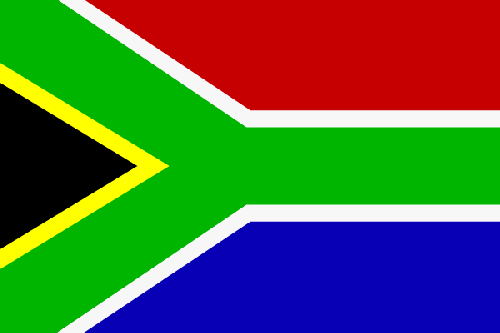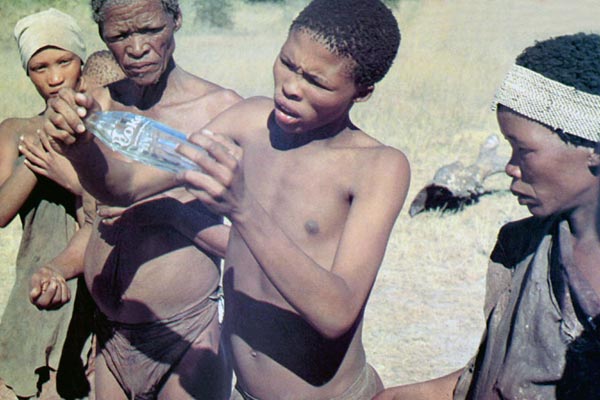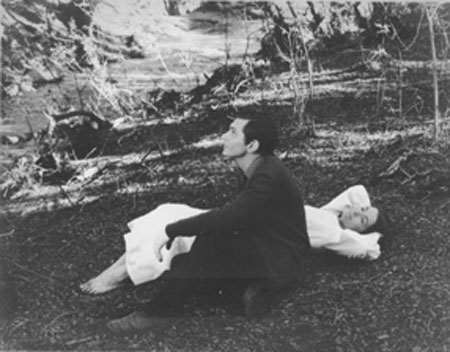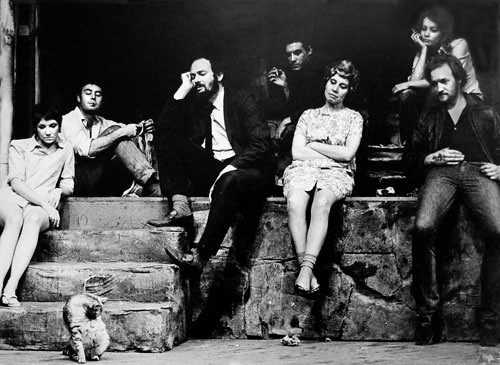Lost Continent:
Cinema of South Africa
By: The Africa Film Project
After the British seized the Cape of Good Hope area in 1806, many of the Dutch settlers (the Boers) trekked north to found their own republics. The discovery of diamonds in 1867 and gold in1886 spurred wealth and immigration and intensified the subjugation of the native inhabitants. The Boers resisted British encroachments, but were defeated in the Boer War (1899-1902). The resulting Union of South Africa operated under a policy of apartheid – the separate development of the races. The 1990s brought an end to apartheid politically and ushered in black majority rule.
Since 1910 over 1350 feature films have been made in South Africa. The first newsreels were filmed at the front during the Anglo-Boer War 1889 – 1902, and early projection devices were used around the gold fields in Johannesburg. The story of the South African film industry begins with the establishment of African Film Productions (AFP) and the production of the first fiction film called, “The Great Kimberley Diamond Robbery” in 1910. Between 1916 and 1922 forty-three films were made by the AFP owned by Isadore William Schlesinger. The multi-national Schlesinger entertainment giant, AFP, dominated the local film scene until 20th Century Fox bought out Schlesinger’s interests in 1956. After 1948 and the introduction of apartheid policy strategies, the film industry became fractured and fragmented along racial and linguistic lines
During the 1950s Jamie Uys attracted Afrikaner-dominated capital for independent production and persuaded the government to provide a subsidy for the making of local films. The political climate in South Africans well as ineffective state-subsidised film structures resulted in severe fragmentations of the industry. Since 1956 and the introduction of a regulated subsidy system, government and big business have collaborated to manipulate cinema in South Africa. It was initially a cinema for whites only; of the 60 films made between 1956 and 1962 were in Afrikaans – four were bilingual and the remaining 13 were English. Since 1962 Afrikaner capital became a significant factor in the industry: the insurance company SANLAM acquired a major interest in Ster-Films and by 1969, Satbel (Suid Afrikaanse Teaterbelange Beperk) was formed, and the financing and distribution for films in South Africa were in the hands of one large company – except for a few cinemas owned by CIC-Warner. The films made in the 60s did not explore a national cultural psyche, ignoring the socio-political turmoil and the realities experienced by black South Africans, focusing on the ideals of the Afrikaners.
Hosting the world cup this summer has given a new hope to the country. It remains to be seen if South Africa’s cinema will benefit from the recent event and only time will tell.
Soccer Cinema is a travelling cinema, bringing some of the world’s best soccer documentaries to 50 small towns, villages and townships, spread across all 9 South African provinces.Ahead of the FIFA WC, Soccer Cinema’s journey started on 6 April 2010 in Cape Town and ended there on 2 June 2010, followed by a Soccer Cinema Festival held at the Labia Cinema from 5 to 10 June. The key objective of the project was to share a common passion and build unity in South Africa by inspiring South Africans through documentary cinema with insight into famous players, teams as well as incredible highlights and events from the game’s colourful past. Soccer Cinema set up its mobile screen in small remote towns that will not be able to experience the World Cup live, towns with special histories.The films screened were sourced from broadcasting commissioning editors and filmmakers from across the world to provide access to the best documentary films ever made about soccer.
Below is a list of ten film makers who have sculpted and shaped the history of South African cinema.
1.Joseph Albrecht
Joseph Albrecht was a pioneer in South African film making. One of his first films The Piccanin’s Christmas was a cute children’s tale featuring a bright little herdboy and a nasty white witch who turns out to be his more kindly employer on the farm
Sarie Marais is the title of the first South African talking picture, made in 1931. Filmed in Johannesburg, Sarie Marais manages to pack a lot into its 10-minute running time. Set in a British POW camp, the film concentrates on a group of Boer prisoners as they pass the time under the watchful eye of their British captors. One of the internees, played by Billy Mathews, lifts his voice in song with the popular Afrikaans patriotic tune “My Sarie Marais”. His enthusiasm catches on with the other prisoners, giving them hope for the future. Afrikaner nationalism was emerging as a force in these years, and Sarie Marais portrayed the British cultural and economic imperialism negatively (the desire to spread the English language, culture and influence even where it was unwelcome). Shortly after this film’s release, a group of Afrikaner nationalists established a film production organisation called the Reddingsdaad-Bond-Amateur-Rolprent Organisasie (Rescue Action League Amateur Film Organisation), which rallied against British and American films pervading the country. In 1938 Albrecht made the epic and very costly film Bou Van ’N Nasie, retelling of the history of South Africa from 1652 to 1910 and made to co-incide with the 100th anniversary of the Great Trek (1838)
The Piccanin’s Christmas 1917
Isban Israel 1919
Sarie Marais 1931
Bou Van ’N Nasie 19382.Jamie Uys
He made his debut as a film director in 1951 with the Afrikaans-language film Daar doer in die bosveld. He directed 24 films in total, and is South Africa’s best known film maker. Uys received the 1981 Grand Prix at the Festival International du Film de Comedy Vevey for The Gods Must Be Crazy, and in 1974 he received the Hollywood Foreign Press Association award for best documentary for Beautiful People. The two Beautiful People films were documentaries about the plant and animal life in South Africa, Namibia, Botswana and Zimbabwe, especially desert creatures. A highlight of the film included a scene with elephants, warthogs, monkeys and other animals staggering around after eating rotten, fermented marula fruit. Jamie Uys’ biggest and best known movie was The Gods Must Be Crazy. In this movie he featured a bushman called N!xau in the lead role. This was a comedy in which a Coke bottle that was thrown out of an aeroplane, fell in the Kalahari Desert and was found by the San tribe. As this was the only “modern” object in their world, it led to strife and it was decided that the bottle had to be returned to the Gods, who must have sent it in the first place. The character played by N!xau was given the task to return it. The movie generated massive word-of-mouth success in America, Japan, Europe, and other territories, with the movie rights initially being sold to 45 countries. It spawned a less successful sequel, The Gods Must Be Crazy II. Uys earlier made another movie set substantially in the Kalahari Desert. This is Lost in the Desert, and tells the story of 8-year-old Dirkie Hayes’ efforts to survive in the desert after surviving a plane crash, whilst his father Anton mounts increasingly desperate efforts to find him. As well as directing the movie, Jamie Uys also played the part of Anton, and his son Wynand Uys played the part of Dirkie. Uys’ other well-known movie was Funny People in 1978, which was a comedy in the same genre as Candid Camera in the U.S., putting unsuspecting people in embarrassing positions. These included a talking postbox, with the voice of a man claiming to be trapped inside, who asks a passer-by for help. When the passer-by returns with his friends, the ‘talking’ postbox is silent, and his friends accuse him of being drunk. The sequel, Funny People II was released in 1983, and features a young Arnold Vosloo, who has since found fame in Hollywood.
Daar doer in die bosveld, 1951
Lord Oom Piet, 1962
Citizens of Tomorrow, 1962
All the Way to Paris, 1965
Dingaka, 1965
The Professor and the Beauty Queen, 1968
Lost in the Desert, 1969
Beautiful People, 1974
Funny People, 1977
Gods They Must Be Crazy, 1980
Funny People II, 1983
The Gods Must Be Crazy II, 19893.Jans Rautenbach
Born in Boksburg in 1936, Jans Rautenbach is arguably South Africa’s most celebrated and, at the same time, most controversial filmmaker. He began his career in the film industry working for Jamie Uys Film Productions and can be glimpsed as a bar patron in Emil Nofal’s Kimberley Jim.
When Emil Nofal and Jamie Uys parted company, Nofal started his own production company with Rautenbach and thus began what could be considered South Africa’s golden age of cinema, with the partners releasing King Hendrik (1965), Wild Season (1967), Die Kandidaat (1968) and their most controversial and thought provoking feature Katrina (1969). The latter film is still considered to be a milestone in South African cinema – a searing examination of South Africa’s unjust racial policies under Apartheid – and also a film which was applauded (instead of being vilified) by those who instituted those exact same unjust laws. In 1970 Rautenbach created his masterpiece Farewell Johnny (Jannie Totsiens) The Citizen Kane of South African cinema. In a private asylum for the insane, seven patients play a dangerous game of life and death with a catatonic new arrival. With echoes of The Magus, the works of Alain Robbe-Grillet and Pasolini’s Theorem, Jannie brings the panacea of love to one patient and death’s finality to another.
King Hendrik, 1965
Wild Season, 1967
Die Kandidaat, 1968
Katrina, 1969
Jannie totsiens 1970
Ongewenste vreemdeling, 1974
Broer Matie, 19844.Dirk De Villiers
Devilliers was South Africa’s most prolific film maker. He was known as a king of the sexploitation film and b movie, and was notorious for being a ladies man. His first feature film as director was in the light comedy Jy Is My Liefling, starring Franz Marx (also in his first film role) and Min Shaw, where he also acted as Franz Marx’s boss. He followed this up with one of his finest films, Die Geheim Van Nantes, an adaptation of the famous Springbok Radio serial, starring the entire voice cast including Pieter Hauptfleisch, Francois Du Bruyn, Dawid Swart and Raedawn Stevens. Among his other films, his 1972 thriller My Broer Se Bril, the adoption drama Met Liefde Van Adele (1974), the adventure film The Virgin Goddess (1974) and the euthanasia – oriented drama Decision To Die (1978) as well as his international successes Glenda (1976) and The Diamond Hunters (1976), based on the book by Wilbur Smith and starring David McCallum and Hayley Mills.
Jy Is My Liefling, 1967
Die Geheim Van Nantes, 1969
My Brother Se Bril, 1972
Met Liefde Van Adele, 1974
The Virgin Goddess, 1974
Glenda, Snake Dancer, 1976
Diamond Hunters, 1976
Decision To Die, 19785.Richard Stanley
Richard Stanley is the award-winning South African-born filmmaker. Stanley made his first short film Rites of Passage in his native South Africa. The short film gained a cult reputation and enabled Stanley to continue working in the usa and England. His first feature film was, the sci-fi movie Hardware (1990). A low budget movie about a mad-dog android loose in an apartment was released in 1990. Critics slammed it as a Terminator rip-off, yet the film became a financial success. The 1.5 million dollar budget was paid back quite handsomely and continuation was imminent. In 1992, Stanley returned to South Africa and filmed Dust Devil (1992), a story based on the myth of a Namibian serial killer. A fallout with the distributors led to the re-cutting of the US version, while the bankruptcy of the British-based production company Palace Pictures temporarily shut the post-production down in Europe and the film remained mauled or unfinished, depending how you look at it. Finally Stanley himself managed to finance a new, restored print from the original negative, which has later gained a cult following similar to Hardware. His third feature was to be The Island of Dr. Moreau (1996), an adaptation of the famed H.G. Wells novel. Unfortunately it ended up a victim of creative disputes, leading to him being sacked a few days after production began. The finished film, released in 1996, carries little to no resemblance to the version he was originally set to make, using only about two words of his original script. Stanley has made several well known documentaries including White Darkness about Haiti’s voodoo culture and the Secert Glory about a Nazi officer’s search for the Holy Grail.
Rites of Passage, 1983
Incidents In An Expanding Universe, 1985
Hardware, 1990
Dust Devil, 1992
Secret Glory, 2001
White Darkness, 20026.Darrell Roodt
South African filmmaker/screenwriter Darrell Roodt made an international name for himself with his debut feature A Place of Weeping (1986), a passionate condemnation of apartheid. Educated at the University of Witwatersrand, South Africa, he gained further acclaim for The Stick (1988), another look at the anti-apartheid struggle. In 1990, he made his first film with American backing, Jobman (1990). Roodt’s best-known film is his adaptation of the anti-apartheid stage musical Sarafina! (1992) starring Whoopi Goldberg. He has since alternated between making films in Hollywood and South Africa. His Hollywood films have never been as successful though.
A Place of Weeping, 1986
the Stick, 1988
Jobman, 1990
Sarafina!, 1992
Cry the Beloved Country, 1995
Second Skin, 2000
Yesterday, 2004
Lullaby, 2008
Winnie, 20117.Oliver Schmitz
Oliver Schmitz (born 1960) is a South African film director and screenwriter. He has directed eleven films since 1988. His film Mapantsula was screened in the Un Certain Regard section at the 1988 Cannes Film Festival. Mapantsula tells the story of Panic, a petty gangster who inevitably becomes caught up in the growing anti-apartheid struggle and has to choose between individual gain and a united stand against the system, and remains one of the hardest hitting films to come from South Africa. His next film Hijack Stories was a far glossier film but was a big success. It tells the story of one man’s dedication to “learning by doing” has dangerous consequences when he tries to land a TV role as a criminal in this drama set in South Africa. Sox Moraka (Tony Kgoroge) is a young actor from a comfortable, middle-class background who thinks he may have gotten his big break when he auditions for a television series, playing the roughneck leader of a township street gang . However, Sox flubs the audition, and the producers inform him he’s just not convincing in the role. Eager to prove that he can play “street” if he wants to, Sox connects with Zama (Rapulana Seiphemo), a friend from childhood who is now a hard-core gang banger, and asks Zama to show him the ropes. Since then Schmitz has moved between South Africa and Germany making tv programmes and commericals. In 2010 he returned with Life Above All, a touching mother-daughter relationship that reflects the modern South Africa.
Mapantsula, 1988
Hijack Stories, 2000
Life Above All, 20108.Gavin Hood
Gavin Hood (born 12 May 1963) is a South African filmmaker, screenwriter, producer and actor, best known for writing and directing the Academy Award-winning Foreign Language Film Tsotsi (2005). He is the director of the 20th Century Fox film X-Men Origins: Wolverine, released on 1 May 2009. He is currently working on a film about the 1925 serum run to Nome of Alaska and Balto, the sled dog that became a celebrity because of the run. His first feature film, A Reasonable Man, came in 1999. The film portrays the accidental killing of a young child who is mistaken for a tokoloshe. He also starred in, co-produced and wrote the script for this movie. Hood then went on to direct the Polish language 2001 feature film In Desert and Wilderness (W pustyni i w puszczy) when the original director fell ill. This was followed by *Tsotsi * in 2005. Tsotsi won the 2005 Academy Award for Best Foreign Language Film and was nominated for the Golden Globe for Best Foreign Language Film in 2006. Gavin Hood was also nominated for the 2005 Non-European Film – Prix Screen International at the European Film Awards for his work on the film. Now working in Hollywood it is hoped that Hood may return to South Africa one day to shoot a smaller budget film.

the Storekeeper, 1998
A Reasonable Man, 1999
In Desert and Wilderness, 2001
Tsotsi, 2005
Rendition, 2007
X-Men Origins, 20099.Mark Dornford-May
Dornford-May is a British born director of both film and theatre. He first worked as a director for the Royal Shakespeare Company, as well as for a community theatre in Stoke. In the 1990s, he started the Broomhill Opera with musical director Charles Hazlewood. In 2001, the two men assembled a cast of local South African singers to form a musical company, Dimpho di Kopane. They staged an adaption of Bizet’s Carmen and a version of the Chester Mystery Plays called The Mysteries-Yiimimangaliso for the Spier Festival. Dornford-May also took his productions on tour to Australia and to the East End where they received positive reviews. After a four-week period of rehearsal, Dornford-May began to film a Xhosa language version of his stage production of Carmen, U-Carmen e-Khayelitsha. The film was shot entirely on location in Cape Town, South Africa without dubbing. Dornford-May received the Golden Bear Award at the 2005 Berlin International Film Festival for the film.
Son Of Man, 2006
U-Carmen, 200510.Zola Maseko
Even with apartheid finished and many films being released charting the plights of black people in South Africa the director’s chair is still white dominated. Zola Maseko is a director aiming to end this and his film Drum struck gold at FESPACO film festival winning the Golden Stallion. This film is a visually stunning epic chronicle of life in Sophiatown before the apatheid government bulldozed this beacon of non racialism. Maseko has yet to make another film and one can only hope that him and many other black filmmakers will get to make more films and tell their own stories.
Drum, 2004
Life and Times of Sarah Baartman
A Drink In the Passage, 2002SOME OTHER INFLUENTIAL FILMS TO COME OUT OF SOUTH AFRICA
Hansie, Regardt Van Den Bergh, 2008
the Mother’s House, Francois Verster, 2005
Bitter Water, Garth Meyer, 2007
Meokgo and the Stickfighter, Teboho Mahlatsi, 2007
A Trade of Cultures, Wynard Dreyer, 2005
Max and Mona, Teddy Mattera, 2004
Born Into Strugle, Rehad Dessai, 2005
the World Unseen, Shamim Sarif, 2007
Gangster’s Paradise: Jerusalema, Ralph Ziman, 2008
District 9, Neill Blomkamp, 2009
The Struggle Against Apartheid: Come Back Africa, Lionel Mogosin, 1959
End of the Dialogue, Antonia Caccia, 1970
Jemima and Johnny, Lionel Ngakane, 1965
Saturday Night At the Palace, Robert Davies, 1987
Boesman and Lena, Ross Devenish, 1972
My Country My Hat, David Bensusan, 1981
Summer Is Forever, Cedric Sundstrom, 1971
Land Apart, Svenn Persson, 1974
Die Storie van Klara Viljee, Katinka Heyns, 1991
Bunny Chow Know Thyself, John Barker, 2007
Jump the Gun, Les Blair, 1997
the Man Who Drove With Mandela, Greta Schiller, 1998
Long Run, Jean Stewart, 2000
Stander, Bronwen Hughes, 2003
Forever Young, Forever Free, Ashley Lazarus, 1976
Shirley Adams, Oliver Hermanus, 2009
Fuck Off Police Car, Bryan Little, 2009
Behind the Rainbow, Jihan El Tahri, 2009
On the Other Side of Life, Stefanie Brockhaus, 2009
Pumzi, Wanuri Kahiu, 2009
the Tunnel, Jenna Bass, 2009
Panic Mechanic, David Lister, 1997
Breekpunt, Daan Retief, 1971
Netnou Hoor Die Kinders, Franz Marx, 1977
Bankrower, Manie Van Rensberg, 1972
Siener in die Suburbs, François Swart, 1971
SOME FILMS SET IN SOUTH AFRICA
Waati, Souleymane Cisse, 1995, Mali
Gandhi, Richard Attenborough, 1982, UK
Invictus Clint Eastwood, 2009, USA
Goodbye Bafana, Billie August, 2007, USA
The Making of the Mahatma, Shyam Benegal, 1996, India
Rough Aunties, KIm Longinotto, 2008, UK
the Power Of One, John G Avildsen, 1992, USA
Zulu, Cy Endfield, 1964, UK
the Burning, Stephen Frears, 1968, UK
Country of My Skull, 2004, John Boorman, USA
Cry Freedom, Richard Attenborough, 1987, UK
South Africa Belongs To Us, Chris Austen, 1980, Germany
the Colour of Freedom, Billie August, 2007, Belgium, France, Germany, Italy, UK,
Disgrace, Steve Jacobs, 2008, Australia
Skin, Anthony Fabian, 2008, UK
Mrs Mandela, Manuel Samuels, 2010, UK

























